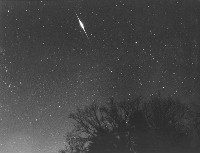Satellites
These are man-made objects launched into space and orbiting at various heights and speeds many kilometres above the atmosphere. They are used for many purposes, such as telecommunication links between centres of population, or weather mapping. Satellites can only be observed as lights in the night sky. Some are very bright and prominent, but most of the many hundreds that are visible are dim and would only be noticed by a sharp-eyed observer in dark surroundings. They are white, but can take on colour tinges if seen through thin cloud or smoke. Their speed takes them across a reasonable arc of sky in several minutes (up to 20 minutes) and so is noticeable, even to a casual observer.
Light reflecting off the antennas of Iridium communication satellites can produce very intense flashes (at magnitude –7 or more) lasting several seconds, which can be predicted for specific dates and locations. There are one or two problems that have to be considered here. One is the question of Autostasis, similar to Autokinesis (as referred to in the section about stars). It causes the continuously moving satellite to appear to hover or even to have a jerky motion. Overall it will continue its sweeping arc and cannot alter direction, and so the effect is detectable.
The other important feature is the sudden disappearance of a satellite as it enters the earth’s shadow in space. Since the light we see is that reflected off the shiny surface of the satellite by the sun (which is beyond the earth so far as the satellite is concerned) there comes a point where the sun disappears, relative to the satellite, as it passes out of sight behind the earth. Hence the satellite enters shadow and its light cuts off dramatically. Most observations of steady white lights on continuous tracks are probably satellites.
One interesting sighting relates to the Naval Ocean Surveillance System (NOSS) satellite formations, each having two or three satellites in close proximity to one another. Normally these satellites are relatively dim to the unaided eye, but on occasion they brighten sufficiently to be easily seen in a dark sky. Observers could be surprised by such sighting, and believe that they observed a triangular UAP.
An illustration of such case can be found on the FOTOCAT Report #4, p177 (Norway in UFO photographs: The first catalogue. By Vicente-Juan Ballester Olmos and Ole Jonny Brænne, http://www.box.net/shared/jz8mqdxuss). An amateur astronomer transmitted in 2005 to the Norwegian organisation (UFO-Norge) a report from an amateur astronomer, who had photographed Mars through a Helios telescope, He reported that he first took a photo at 18:45 with an exposure time of 4 seconds, but it came out very fuzzy. Two minutes later he took another photograph, this time with 1/8 second exposure time. On this photo he also registered three streaks of light. Birger Andresen (Trondheim Astronomical Society) checked for possible satellites, and found that a triple satellite had indeed passed in front of or near the position of Mars, but the time was a little off. Later it was found that the time on the digital camera was a little off as well, and when corrected it fits perfectly with the satellite’s passing. This was actually a NOSS (Naval Ocean Surveillance System) satellite formation, having three satellites in close proximity to each other.
Information on the NOSS double and triple satellite formations:
http://www.satobs.org/noss.html
Telltale signs: Steady motion in continuous arc (despite apparent `wavers’ or `jerks’), steady whitish light (slight pulsations are possible if the satellite surface is uneven and it is rotating), observation time in the order of 2-20 minutes.
Resources:
Satellite Flybys :
http://spaceweather.com/flybys/index.php?PHPSESSID=f3sspcg2p3dfketdov8un85ih6
http://heavens-above.com/
http://www.n2yo.com/
Catch a Flaring/Glinting Iridium:
http://satobs.org/iridium.html
New 2013: For satellite re-entries (trajectories of incoming fragments) :
http://www.satview.org/
